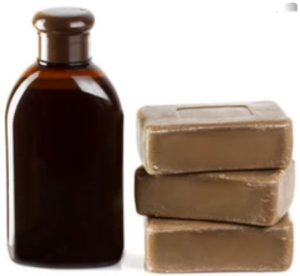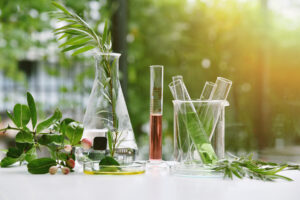Office of the VP for Communications – Keeping alumni and friends connected to U-M
Personal care product advertising seems to be everywhere, particularly hyped on TV by celebrity “skinfluencers” hawking vanity lines of “natural skincare” products.
Advertising touts the need for safe and nontoxic products, suggesting that only their products are “clean” and “natural” compared to all other products in the marketplace.
The growth in the cosmetics industry (targeting women) is astounding! The average woman uses 12 such products containing 168 different chemicals each day. Similarly, sales of “natural” beauty aids are also heating up for men. Bloggers, celebrities, and social media influencers are busier than ever, convincing male consumers they need to cover up, exfoliate, firm up, or hide. In a recent survey of 4,400 men in the U.S., 20 percent of respondents reported they had worn makeup or concealer. Thirty-three percent of men ages 18-29 said they would consider wearing makeup, while another 30 percent of men ages 30-44 said they’d be open to the idea.
The “clean, natural skincare” business is enormous. From 2017-18, this segment of the cosmetic market grew by 23 percent to $1.6 billion, accounting for more than 25 percent of the $5.6 billion of annual skincare sales in 2018. Sales are predicted to top $7 billion by the end of 2022.
The clean beauty business touts the use of ingredients they claim to be natural or clean: the implication is that all other ingredients are therefore toxic. But there seems no rhyme or reason why certain ingredients in these products are better than others. It appears the industry is “cleanwashing” their products to make them more attractive to conscientious shoppers. 
Interestingly, the U.S. Food and Drug Administration (FDA), which regulates and polices personal healthcare products, has yet to define what the terms “clean” and “natural” mean. Moreover, the FDA is not required to test or preapprove cosmetics and their ingredients, except for color additives. Thus, non-dermatologist retailers, bloggers, celebrities, and customers are left to interpret these terms for themselves.
For the most part, the adjectives “clean” and “natural” appear to be nothing more than advertising terms. Without clear, agreed-upon definitions, there is no way of knowing whether a product is “safe.” The Federal Food, Drug, and Cosmetic Act (FD&C) incorporates laws related to food, drugs, and cosmetics in the U.S.
The Federal Food, Drug, and Cosmetic Act (FD&C) incorporates laws related to food, drugs, and cosmetics in the U.S.
Whether a product is a cosmetic or a drug under the law determines that product’s intended use – different regulations apply to each type of product. Companies sometimes violate the law by marketing a cosmetic with a drug claim or by marketing a drug as if it were a cosmetic without adhering to requirements for drugs.
The FD&C Act defines cosmetics by their intended use, as “articles intended to be rubbed, poured, sprinkled, or sprayed on, introduced into, or otherwise applied to the human body … for cleansing, beautifying, promoting attractiveness, or altering the appearance.” Examples include skin moisturizers, perfumes, lipsticks, fingernail polishes, eye and facial makeup preparations, cleansing shampoos, permanent waves, hair colors, deodorants, and any substance intended for use as a component of a cosmetic product.
The FD&C Act defines drugs, in part, by their intended use, as “articles intended for use in the diagnosis, cure, mitigation, treatment, or prevention of disease” and “articles (other than food) intended to affect the structure or any function of the body of man or other animals.”
Some products meet both definitions when the product has two intended uses. For example, shampoo is a cosmetic when its intended use is to cleanse the hair. An antidandruff treatment, in contrast, is a drug because its intended use is to treat dandruff; thus, antidandruff shampoo is both a cosmetic and a drug. Among other cosmetic/drug combinations are toothpastes that contain fluoride, deodorants that are also antiperspirants, and moisturizers and makeups marketed with sun-protection claims. Such products must comply with the requirements for both being a cosmetic and a drug. Drug regulations are much stricter than cosmetic regulations.
There appears to be little oversight regarding cosmetic contents in this country; it has been nearly 80 years since regulators last revised the federal safety regulations for personal health care products.  But that could change, based on concern about rising rates of different cancers, endocrine disruptors (read this Health Yourself for more about endocrine disruptors), and recent regulatory actions taken by the European Union. Many states and the U.S. Congress are introducing legislation to increase safety for consumers, protect small businesses, and provide regulatory certainty for manufacturers.
But that could change, based on concern about rising rates of different cancers, endocrine disruptors (read this Health Yourself for more about endocrine disruptors), and recent regulatory actions taken by the European Union. Many states and the U.S. Congress are introducing legislation to increase safety for consumers, protect small businesses, and provide regulatory certainty for manufacturers.
The European Union (28 countries) has adopted more stringent and protective laws for cosmetics than we have in the U.S. The EU’s hazard-based, precautionary approach acknowledges that any chemical that links to cancer and congenital disabilities does not belong in cosmetics – regardless of the concentration.
Currently, the EU has banned more than 1,300 cosmetic chemicals found in different makeup, lotions, hair dyes, deodorants, nail polishes, shaving creams, and other beauty products. By contrast, the United States bans and restricts only 11 cosmetic chemicals.
There seems to be discordance between what we know about the science of cancer development and different skincare products and what information is disseminated to consumers. Moreover, the personal care industry has spent more than $1.5 million per year for at least 10 years to lobby Congress into dormancy. They have succeeded.
Below, I list only a few chemicals (typically found in cosmetics) banned in Europe and elsewhere but allowed in the U.S. Research suggests these chemicals relate to long-term health concerns like cancer and reproductive and endocrine dysfunction.
The International Agency for Research on Cancer (IARC) is an intergovernmental agency and part of the World Health Organization. IARC consolidates scientific evidence and classifies the chemicals it reviews into five levels:
Many of the 113 agents listed by IARC as known human carcinogens (Group 1 above) appear in personal care products. Here is a list of the most pervasive cosmetic chemicals sold in the U.S.
Most cosmetics (i.e., chemicals) eventually absorb into the bloodstream. The cumulative effect of daily cosmetic use for years has been shown to have long-term harmful health effects: allergic reactions, cancer, developmental issues in children, liver damage, neurotoxicity, reproductive disorders, skin DNA damage, tumor growth, and endocrine, thyroid and hormone problems.
What you put on your body is as important as what you put in your body.
The Environmental Working Group is a reliable information source on these topics.
References
(Lead image credit: IRA_EVVA)
Informing and useful as always from Vic Katch. Any recommended web sites that make it easier to identify best options would be helpful. I get overwhelmed trying to match lists of what to beware of with product labels.
Reply
The Environmental Working Group is a reliable information source on these topics: http://www.ewg.org.
Reply
Where can we consumers find lists of cosmetic brands that are reasonably “safe”? I visited ewg.org which is filled with information about chemicals, etc. but did not find and recommended brands. Thank you.
Reply
